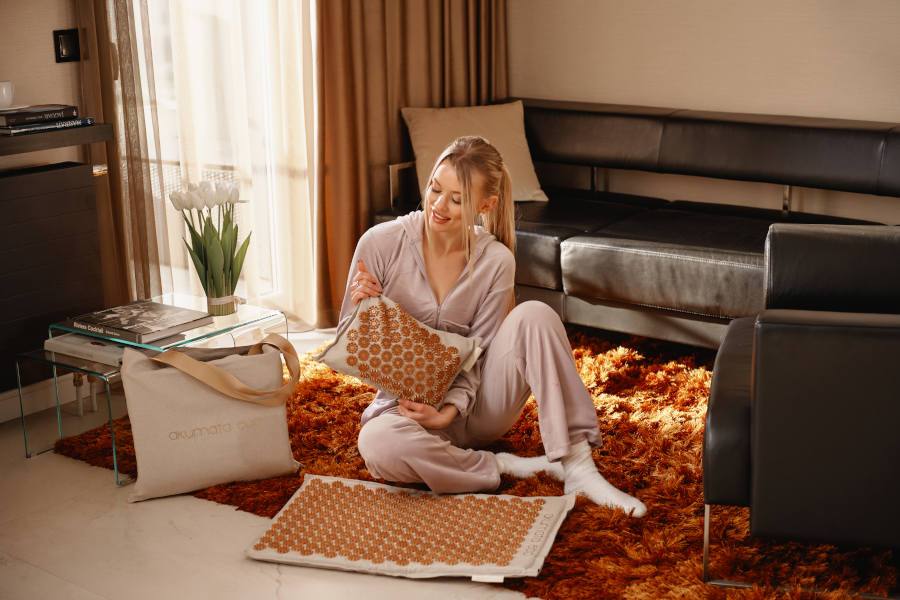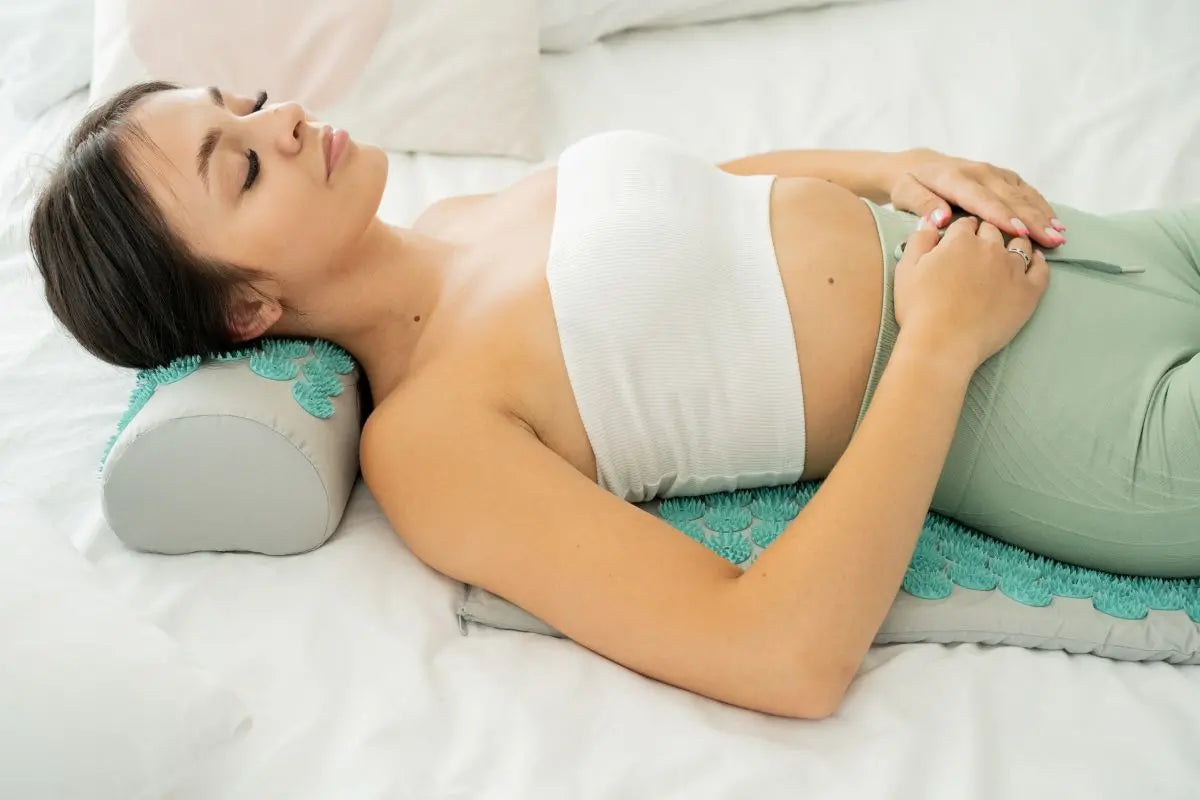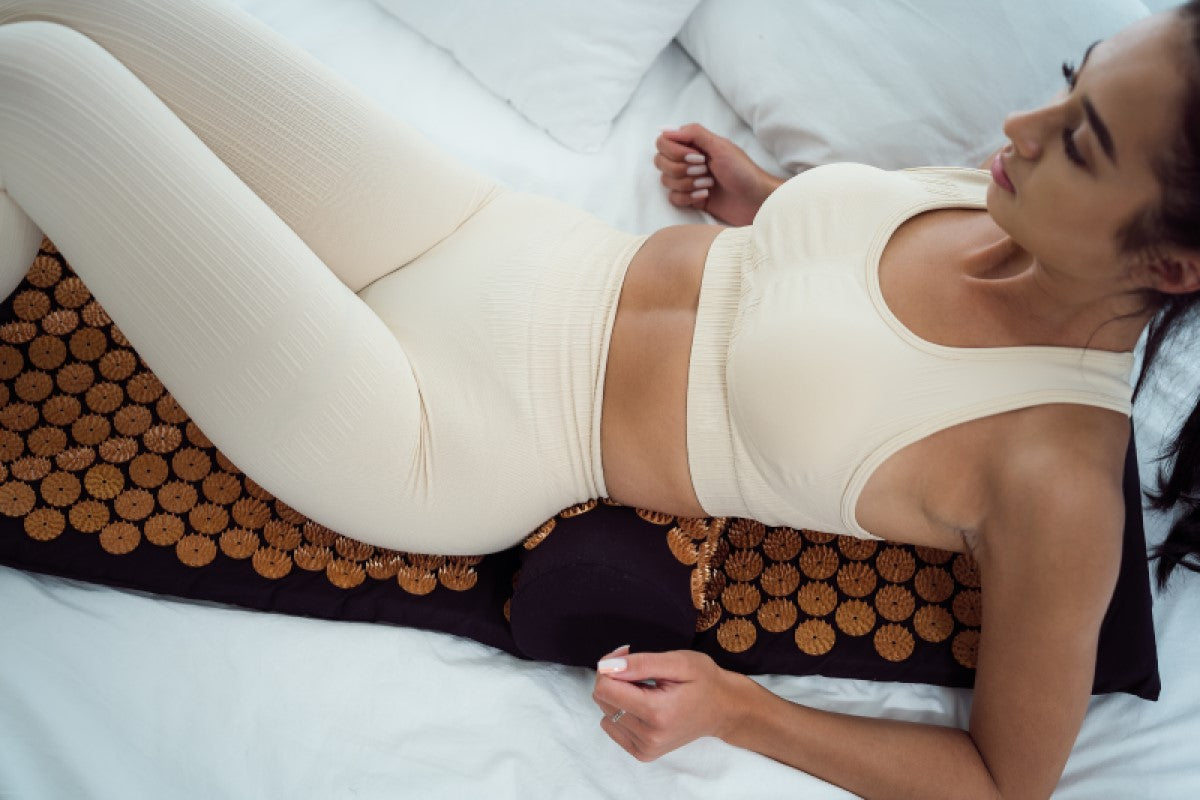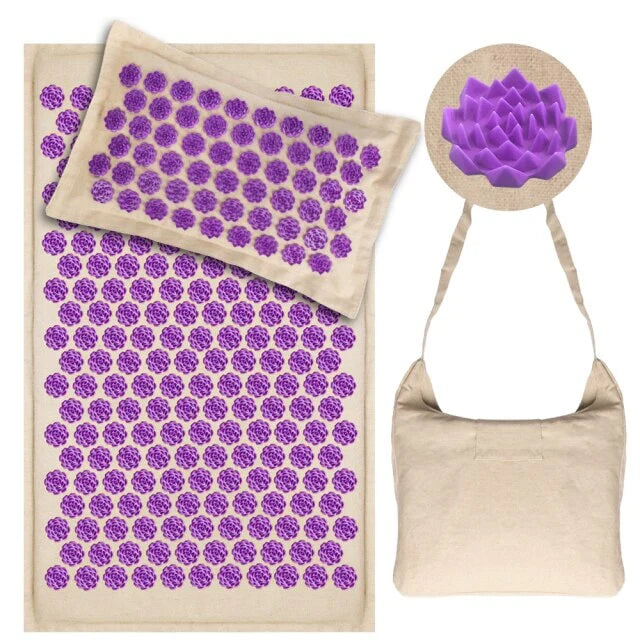Standing on an acupressure mat is a holistic practice that can relax the body, relieve tension, and promote overall well-being. This type of treatment provides pressure to acupuncture points across the entire body through the reflex zones in the feet, offering amazing benefits, such as pain relief and improved circulation.
In this guide, you'll understand the benefits of standing on an acupressure mat, learn easy ways to incorporate it into your routine, and discover new, professional techniques to maximize your experience.
Whether you're familiar with yoga or just getting started, you'll see how standing on the mat can enhance your physical and mental health.
Understanding acupressure mat therapy
What is an acupressure mat?
An acupressure mat is a set of tiny spikes made from plastic that stimulate acupuncture and meridian points across your body. Similar to needles used in acupuncture, these tiny spikes apply gentle pressure to deep points along the body’s energy pathways.
When you stand, sit, or even lie on the mat, it helps to release tension, relieve pain, and relax your muscles. Acupressure mats can be used alongside a pillow for added neck and shoulder relief, or incorporated into your yoga routine.
They are designed to be versatile tools that help you target different areas for maximum effect.
How does standing on an acupressure mat work?
Standing on an acupressure mat works by stimulating the reflex zones in your feet, which are connected to other parts of the body through the nervous system and meridian lines. The plastic spikes, although similar to needles, do not penetrate the skin but still provide a massage-like effect.
Over time, this pressure can help relieve hip, buttocks, and shoulder tension, while also relaxing the feet. For beginners, it's recommended to stand on the mat while wearing socks or to slowly adjust to the sensation by standing for just a few minutes and increasing the time gently.
The science behind acupressure mat therapy
Scientific research shows that acupuncture and acupressure can stimulate the release of endorphins, the body's natural painkillers, and improve blood flow. Studies have shown that consistent use of acupressure mats can help with issues like back pain, neck discomfort, and stress.
The gentle pressure helps align the body's meridians, providing relief to those experiencing chronic pain or tension. By targeting the pressure points on your feet, the mat simply promotes a natural healing process that can result in long-term improvements in health.
The key benefits of standing on an acupressure mat
Boost circulation and energy levels
Standing on an acupressure mat helps improve circulation, particularly in the lower body. The contact between the mat’s spikes and the feet stimulates blood flow, delivering oxygen and nutrients more efficiently throughout the body. This is especially beneficial for people who experience fatigue or poor circulation.
The energy boost you feel after using an acupressure mat is the result of this increased blood flow, which can be felt in the legs, hips, and even the neck and shoulders. Over time, this practice can help reduce bruising and improve recovery from injuries.
Stress reduction and relaxation
Using an acupressure mat can have a deeply relaxing effect on both the body and mind. The pressure applied by the mat's spikes stimulates the parasympathetic nervous system, which promotes a state of calm and relaxation. You can enhance this effect by pairing your mat use with deep breathing or yoga exercises.
For added comfort, consider using a pillow under your neck while you stand or lay on the mat. These techniques help create a holistic experience, allowing you to fully unwind, relieve stress, and improve your sleeping patterns.
Pain relief for feet, legs, and back
Standing on an acupressure mat can effectively relieve pain, especially in the feet, legs, and lower back. The spikes apply pressure to deep acupoints that can help reduce inflammation, ease tension in the shoulders and neck, and even alleviate hip pain.
For those with conditions like plantar fasciitis, this type of treatment can be a natural and non-invasive way to manage pain. Laying on the mat, with bare feet or lying on the floor while supporting your arms and knees, can also provide relief from tension in the stomach and buttocks.
How to use an acupressure mat while standing?
Getting started: step-by-step guide
To begin, place your acupressure mat on a firm surface, like a floor or next to a chair for support. Simply step onto the mat, standing with your feet bare or while wearing socks to reduce the intensity of the spikes. Distribute your weight evenly and maintain a comfortable position for 2-3 minutes.
You can stand gently at first and then gradually increase the time spent standing. If you need additional support, bend your knees slightly or place your hands on a nearby chair. As your body adjusts, you can increase the duration and intensity of your sessions.
Recommended positions for standing on an acupressure mat
There are various positions you can use when standing on an acupressure mat to target different areas of your body. Start by standing with your feet hip-width apart. For a more intense experience, try gently lifting one foot at a time or shifting your weight from one leg to the other.
You can also add a yoga block or pillow for support as you change positions. Incorporating movements like slow, controlled steps or even sitting on the mat will engage different muscles and acupoints, helping you achieve deeper relaxation and pain relief.
Tips for beginners
If you're new to using an acupressure mat, take it slow. Start with short sessions of 2-3 minutes and gradually build up to longer periods. Note that it’s normal to feel some discomfort initially, but this should subside as your body adjusts. You can begin by standing on the mat while doing simple tasks, like brushing your teeth or working at a standing desk.
For added comfort, use a pillow under your neck or back when lying down. Over time, you can increase the intensity by standing longer or removing socks for a bare-footed experience.
Advanced techniques and creative uses
Combine standing on the mat with stretching
One way to enhance your acupressure mat experience is to combine it with yoga stretches or light exercises. As you stand on the mat, slowly raise your arms overhead, engage your core, and stretch your back to target different muscle groups.
Adding simple stretches like calf raises or lunges can deepen the pressure and help relieve tension in the hips, legs, and shoulders. These stretches allow you to make the most of your time on the mat while also increasing flexibility and range of motion.
Integrating acupressure mat standing into daily life
Integrating acupressure mat standing into your daily routine is easy and convenient. You can use the mat while working at a standing desk, during a TV show, or while doing household chores. Even spending a few minutes on the mat daily can provide significant benefits.
You can also incorporate mat use into your bedtime routine by standing on it for a few minutes before sleeping. Whether standing, laying, or even sitting on the mat, you’ll find it’s a versatile tool for improving your well-being.
Using the mat to improve posture
Standing on an acupressure mat naturally encourages better posture. The uneven surface requires you to engage your core muscles and maintain balance, which helps align your spine and relax your neck and shoulders. Over time, this improved posture can help alleviate tension in the back and reduce discomfort while sitting or standing for long periods.
You can also sit on the mat with your knees bent to target pressure points in your stomach, hip, and buttocks areas, enhancing overall body awareness and balance.
Precautions and best practices
Who should avoid standing on an acupressure mat?
While acupressure mats are generally safe for most people, certain individuals should avoid them. If you have sensitive skin, open wounds, or conditions like plantar fasciitis, consult with a healthcare professional before using the mat. Pregnant women and those with circulatory issues should also seek medical advice.
Note that standing on the mat for too long can cause temporary bruising, especially if used with too much pressure. Always understand your body’s limits and stop using the mat if you feel any pain or discomfort.
How long should you stand on an acupressure mat?
For beginners, start by standing for 2-3 minutes and gradually work your way up to 10-15 minutes as your body adjusts. Once you’re comfortable, you can increase the time to 20 minutes per session, depending on your tolerance level. It’s important to build up slowly and pay attention to how your body reacts to the pressure.
While acupressure mats can provide maximum benefits when used consistently, it’s essential to balance frequency and duration to avoid over-stimulation.
Maintenance and care for your acupressure mat
To keep your acupressure mat in good condition, wipe it down regularly with a damp cloth and mild detergent. Let it air dry fully before storing it in a cool, dry place.
You can also use a disinfectant spray to ensure the plastic spikes stay clean, especially if you use the mat frequently. Proper care will prolong the life of your mat and keep it hygienic for future use.
Radically new: acupressure mat as a fitness tool
Standing workouts on acupressure mats
For those looking to add intensity to their workouts, using an acupressure mat during exercises like squats or lunges can challenge your balance and engage your core. The uneven surface stimulates multiple muscle groups, making your workout more effective.
Standing on the mat while doing bodyweight exercises can increase blood flow, improve flexibility, and offer a full-body massage. This practice enhances your workout routine and provides the additional benefit of deep acupressure stimulation.
Enhancing mindfulness with acupressure mat standing
Incorporating mindfulness into your acupressure mat routine can deepen the experience and reduce stress. As you stand on the mat, focus on your breath and be mindful of the sensations in your body.
You can also try a guided meditation or yoga session while standing to connect more deeply with the present moment. This combination of physical and mental relaxation offers a unique way to unwind and relieve tension.
Acupressure mat standing for focus and productivity
Standing on an acupressure mat during work breaks can enhance your focus and productivity. The stimulation from the mat increases blood flow to the brain, helping you stay alert and energized throughout the day. Incorporating a few minutes of acupressure mat standing into your daily routine can help clear mental fog and improve concentration.
This holistic approach to well-being can make a significant difference in how you feel both physically and mentally during the workday.
Frequently asked questions
1. How long should you stand on an acupressure mat?
For beginners, it's recommended to stand on an acupressure mat for 2 to 3 minutes, gradually increasing the time as your body adjusts to the pressure. Over time, you can work your way up to 10-15 minutes per session, with a maximum duration of around 20 minutes for experienced users.
Standing on the mat regularly helps stimulate blood circulation, relieve tension in the legs, and improve energy levels. When you start to feel comfortable, try stepping onto the mat without socks to get a deeper sense of the pressure. Always allow your body to rest afterward for proper recovery.
2. What are the benefits of standing on an acupressure mat?
Standing on an acupressure mat offers a wide range of health benefits, including improved blood circulation, stress relief, and enhanced relaxation. The pressure points on the mat target reflex zones in the feet, helping to reduce pain in the legs, shoulders, and lower back.
Many users find that standing on the mat also alleviates sore muscles by increasing blood flow and reducing tension. Incorporating acupressure mat standing into your routine can help improve your sense of well-being and rest by relieving daily physical strain.
3. Can standing on an acupressure mat help with pain relief?
Yes, standing on an acupressure mat can provide effective pain relief for issues like foot pain, sore legs, and shoulder discomfort. The spikes stimulate pressure points in the feet, releasing tension and improving circulation to promote healing.
Many users also find relief from sore muscles in the hips and shoulders. Consistent use of the mat, combined with rest periods, can lead to long-term pain management. If needed, you can place a towel on the mat for extra comfort while adjusting to the pressure.
4. Is it safe to stand on an acupressure mat every day?
Yes, it is generally safe to stand on an acupressure mat every day, as long as you listen to your body and avoid overuse. Beginners should start by using a towel for added cushion or wearing socks, and over time, you can increase the duration as your feet adjust.
Regular daily use can help improve posture, relieve sore muscles, and reduce tension in the shoulders and back. After standing, it’s important to give your body time to rest, either by sitting or lying down on a bed or couch. Always consult a professional if you have underlying health concerns.
5. Can you wear socks while standing on an acupressure mat?
Yes, wearing socks while standing on an acupressure mat is a great way to reduce the intensity of the spikes, especially for beginners. Socks provide a cushion, making the experience more comfortable for those who find direct pressure too intense.
You can also place a towel on the mat for additional comfort. As you become more accustomed to the pressure, try standing barefoot to enhance the experience and get a better sense of the pressure points. Over time, this will also help alleviate sore muscles in the shoulders and legs.
6. Does standing on an acupressure mat help with stress?
Absolutely. Standing on an acupressure mat can significantly reduce stress by activating the parasympathetic nervous system, promoting relaxation. This type of treatment is great for relieving tension in the feet, shoulders, and sore muscles after a long day.
To enhance the stress-relieving effects, try standing on the mat just before bed or after a yoga session. Pairing this with deep breathing exercises or mindfulness techniques can create a calming sense of well-being. Regular use helps reduce overall stress and improves rest.
7. Can standing on an acupressure mat improve posture?
Yes, standing on an acupressure mat can improve posture. The uneven surface requires your body to engage core muscles for balance, which encourages better spinal alignment. As you stand, the mat stimulates reflex points in your feet that can relieve tension in the shoulders and sore muscles of the back.
Over time, this helps correct posture and reduces the likelihood of sore shoulders from poor alignment. Combining mat use with proper rest and recovery, such as lying flat on a bed, further enhances posture improvements.
8. How should beginners start using an acupressure mat?
Beginners should start by standing on the acupressure mat for 2-3 minutes, wearing socks or placing a towel over the mat to soften the sensation. Gradually increase the time as you get used to the pressure. You can also incorporate mat use into your routine by standing on it while brushing your teeth or watching TV.
After each session, allow yourself to rest, either by sitting or lying on your bed. Over time, stepping onto the mat barefoot will enhance the effects and help you manage sore muscles.
9. Can standing on an acupressure mat improve circulation?
Yes, standing on an acupressure mat can help boost circulation, particularly in the legs, feet, and sore muscles. The pressure from the mat stimulates the reflex points in your feet, improving blood flow and oxygen delivery throughout the body.
This increased circulation can help alleviate sore feet, shoulder tension, and sore muscles, making you feel more energized and refreshed. For maximum results, use the mat regularly, allowing time for rest between sessions to aid in muscle recovery.
10. Are there any risks to using an acupressure mat?
While acupressure mats are generally safe, there are some precautions. People with sensitive skin, certain foot conditions, or circulation issues should consult a healthcare professional before use. Prolonged standing on the mat may cause temporary sore muscles or discomfort, especially if you don't allow time for proper rest.
If you experience any discomfort, you can lay a towel over the mat to soften the sensation. Avoid standing on the mat for too long without giving your feet and shoulders time to recover.








